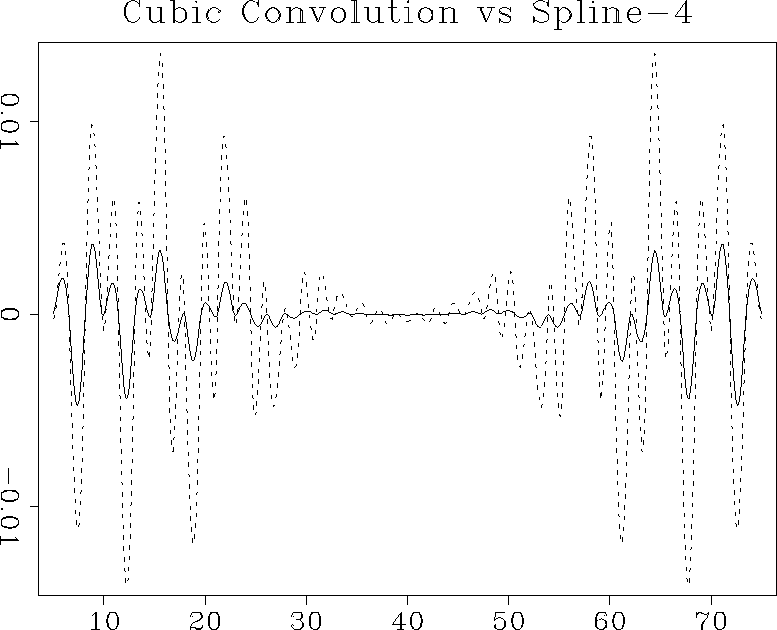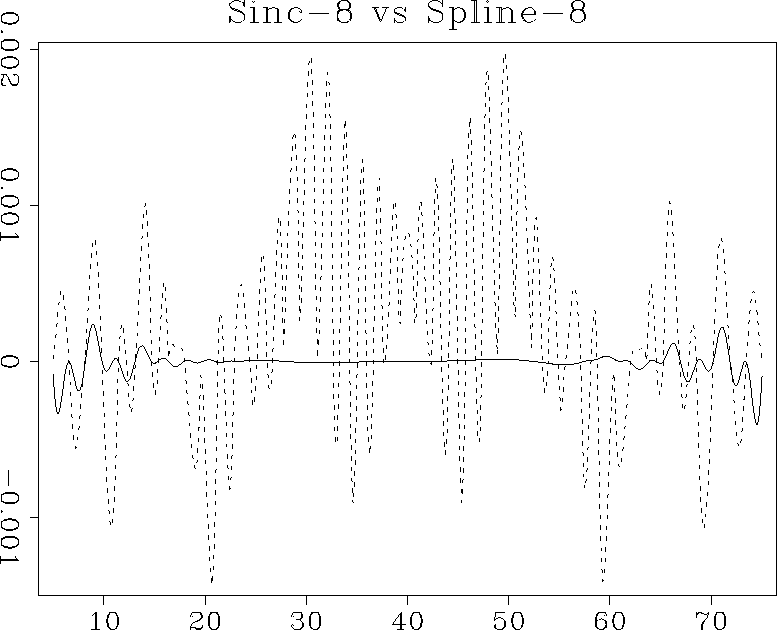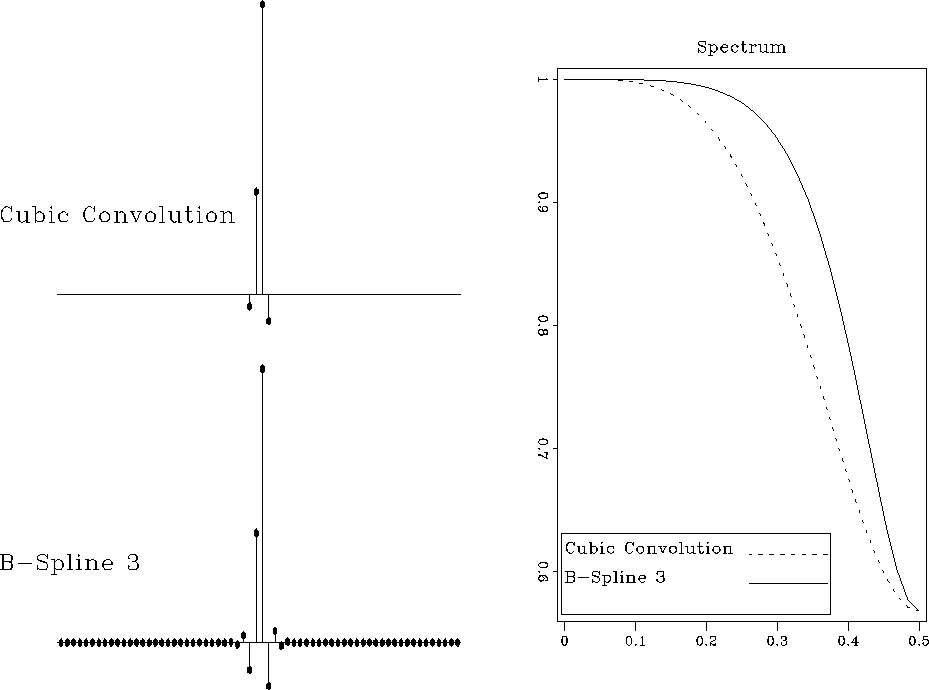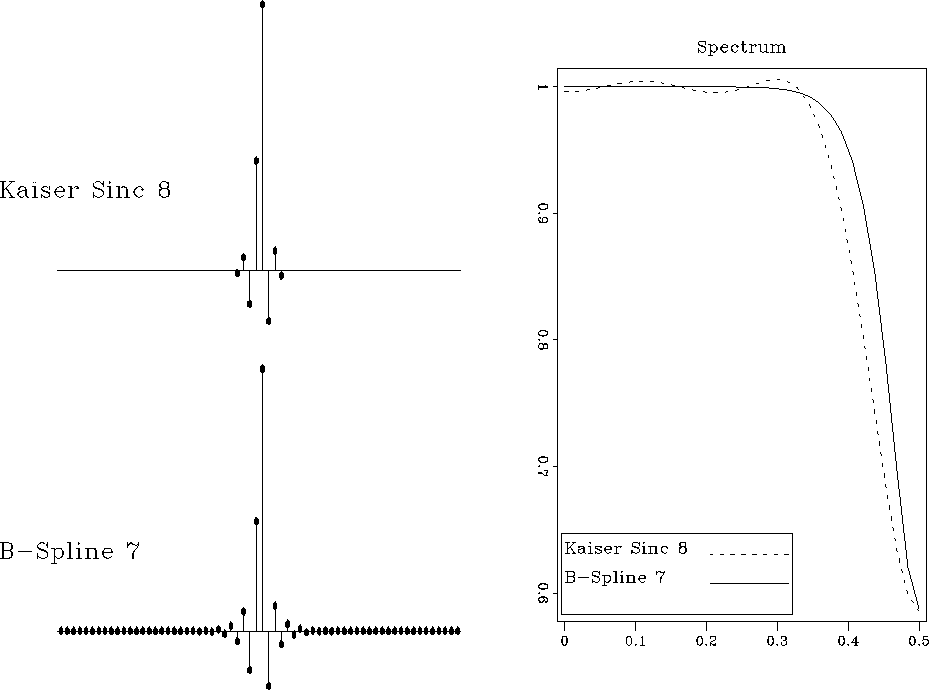




Next: 2-D example
Up: Interpolation with convolutional bases
Previous: Interpolation with convolutional bases
B-splines represent a particular example of a convolutional basis.
Because of their compact support and other attractive numerical
properties, B-splines are a good choice of the basis set for the
forward interpolation problem and related signal processing problems
Unser (1999). According to Thévenaz et al. (2000), they exhibit superior
performance for any given order of accuracy in comparison with other
methods of similar efficiency.
B-splines of the order 0 and 1 coincide with the nearest neighbor and
linear interpolants (![[*]](http://sepwww.stanford.edu/latex2html/cross_ref_motif.gif) ) and (
) and (![[*]](http://sepwww.stanford.edu/latex2html/cross_ref_motif.gif) ) respectively.
B-splines
) respectively.
B-splines  of a higher order n can be defined by a
repetitive convolution of the zeroth-order spline
of a higher order n can be defined by a
repetitive convolution of the zeroth-order spline  (the
box function) with itself:
(the
box function) with itself:
|  |
(68) |
There is also the explicit expression
|  |
(69) |
which can be proved by induction. Here Ckn+1 are the binomial
coefficients, and the function x+ is defined as follows:
|  |
(70) |
As follows from formula (![[*]](http://sepwww.stanford.edu/latex2html/cross_ref_motif.gif) ), the most commonly used cubic
B-spline
), the most commonly used cubic
B-spline  has the expression
has the expression
|  |
(71) |
The corresponding discrete filter  is a centered 3-point
filter with coefficients 1/6, 2/3, and 1/6. According to the
traditional method, deconvolution with this filter is performed as a
tridiagonal matrix inversion de Boor (1978). One can, however,
accomplish the same task more efficiently by spectral factorization
and recursive filtering Unser et al. (1993). The recursive filtering
approach generalizes straightforwardly to B-splines of higher orders.
is a centered 3-point
filter with coefficients 1/6, 2/3, and 1/6. According to the
traditional method, deconvolution with this filter is performed as a
tridiagonal matrix inversion de Boor (1978). One can, however,
accomplish the same task more efficiently by spectral factorization
and recursive filtering Unser et al. (1993). The recursive filtering
approach generalizes straightforwardly to B-splines of higher orders.
Both the support length and the smoothness of B-splines increase with
the order. In the limit, B-splines converge to the Gaussian function.
Figures ![[*]](http://sepwww.stanford.edu/latex2html/cross_ref_motif.gif) and
and ![[*]](http://sepwww.stanford.edu/latex2html/cross_ref_motif.gif) show the third- and
seventh-order splines
show the third- and
seventh-order splines  and
and  , respectively, and
their continuous spectra.
, respectively, and
their continuous spectra.
splint3
Figure 13 Third-order B-spline  (left)
and its spectrum (right).
(left)
and its spectrum (right).




 splint7
splint7
Figure 14 Seventh-order B-spline  (left)
and its spectrum (right).
(left)
and its spectrum (right).





It is important to realize the difference between B-splines and the
corresponding interpolants W(x,n), which are sometimes called
cardinal splines . An explicit computation of the cardinal
splines is impractical, because they have infinitely long support.
Typically, they are constructed implicitly by the two-step
interpolation method outlined above. The cardinal splines of orders 3
and 7 and their spectra are shown in Figures ![[*]](http://sepwww.stanford.edu/latex2html/cross_ref_motif.gif) and
and ![[*]](http://sepwww.stanford.edu/latex2html/cross_ref_motif.gif) . As B-splines converge to the Gaussian function,
the corresponding interpolants rapidly converge to the sinc
function (
. As B-splines converge to the Gaussian function,
the corresponding interpolants rapidly converge to the sinc
function (![[*]](http://sepwww.stanford.edu/latex2html/cross_ref_motif.gif) ). Good convergence is achieved with the help
of the implicitly-generated long support, which results from
recursive filtering at the first step of the interpolation procedure.
). Good convergence is achieved with the help
of the implicitly-generated long support, which results from
recursive filtering at the first step of the interpolation procedure.
crdint3
Figure 15 Effective third-order B-spline interpolant
(left) and its spectrum (right).




 crdint7
crdint7
Figure 16 Effective seventh-order B-spline interpolant
(left) and its spectrum (right).





In practice, the recursive filtering step adds only marginally to the
total interpolation cost. Therefore, an n-th order B-spline
interpolation is comparable in cost with any other method that uses an
(n+1)-point interpolant. The comparison in accuracy usually turns
out in favor of B-splines. Figures ![[*]](http://sepwww.stanford.edu/latex2html/cross_ref_motif.gif) and
and ![[*]](http://sepwww.stanford.edu/latex2html/cross_ref_motif.gif) compare interpolation errors of B-splines and
other similar-cost methods on the example from Figure
compare interpolation errors of B-splines and
other similar-cost methods on the example from Figure ![[*]](http://sepwww.stanford.edu/latex2html/cross_ref_motif.gif) .
.
cubspl
Figure 17 Interpolation error of the
cubic-convolution interpolant (dashed line) compared to that of the
third-order B-spline (solid line).
|
|  |





kaispl
Figure 18 Interpolation error of the 8-point
windowed sinc interpolant (dashed line) compared to that of the
seventh-order B-spline (solid line).
|
|  |





Similarly to the comparison in Figures ![[*]](http://sepwww.stanford.edu/latex2html/cross_ref_motif.gif) and
and ![[*]](http://sepwww.stanford.edu/latex2html/cross_ref_motif.gif) , we can also compare the discrete responses
of B-spline interpolation with those of other methods. The right plots
in Figures
, we can also compare the discrete responses
of B-spline interpolation with those of other methods. The right plots
in Figures ![[*]](http://sepwww.stanford.edu/latex2html/cross_ref_motif.gif) and
and ![[*]](http://sepwww.stanford.edu/latex2html/cross_ref_motif.gif) show that the
discrete spectra of the effective B-spline interpolants are genuinely
flat at low frequencies and wider than those of the competitive
methods. Although the B-spline responses are infinitely long because
of the recursive filtering step, they exhibit a fast amplitude decay.
show that the
discrete spectra of the effective B-spline interpolants are genuinely
flat at low frequencies and wider than those of the competitive
methods. Although the B-spline responses are infinitely long because
of the recursive filtering step, they exhibit a fast amplitude decay.
speccubspl
Figure 19 Discrete interpolation responses
of cubic convolution and third-order B-spline interpolants (left)
and their discrete spectra (right) for x=0.7.
|
|  |





speckaispl
Figure 20 Discrete interpolation responses of
8-point windowed sinc and seventh-order B-spline interpolants (left)
and their discrete spectra (right) for x=0.7.
|
|  |










Next: 2-D example
Up: Interpolation with convolutional bases
Previous: Interpolation with convolutional bases
Stanford Exploration Project
12/28/2000
![[*]](http://sepwww.stanford.edu/latex2html/cross_ref_motif.gif) ) and (
) and (![[*]](http://sepwww.stanford.edu/latex2html/cross_ref_motif.gif) ) respectively.
B-splines
) respectively.
B-splines ![[*]](http://sepwww.stanford.edu/latex2html/cross_ref_motif.gif) ) and (
) and (![[*]](http://sepwww.stanford.edu/latex2html/cross_ref_motif.gif) ) respectively.
B-splines
) respectively.
B-splines ![]() of a higher order n can be defined by a
repetitive convolution of the zeroth-order spline
of a higher order n can be defined by a
repetitive convolution of the zeroth-order spline ![]() (the
box function) with itself:
(the
box function) with itself:
![[*]](http://sepwww.stanford.edu/latex2html/cross_ref_motif.gif) ), the most commonly used cubic
B-spline
), the most commonly used cubic
B-spline 
![[*]](http://sepwww.stanford.edu/latex2html/cross_ref_motif.gif) and
and ![[*]](http://sepwww.stanford.edu/latex2html/cross_ref_motif.gif) show the third- and
seventh-order splines
show the third- and
seventh-order splines ![]() and
and ![]() , respectively, and
their continuous spectra.
, respectively, and
their continuous spectra.


![[*]](http://sepwww.stanford.edu/latex2html/cross_ref_motif.gif) and
and ![[*]](http://sepwww.stanford.edu/latex2html/cross_ref_motif.gif) . As B-splines converge to the Gaussian function,
the corresponding interpolants rapidly converge to the sinc
function (
. As B-splines converge to the Gaussian function,
the corresponding interpolants rapidly converge to the sinc
function (![[*]](http://sepwww.stanford.edu/latex2html/cross_ref_motif.gif) ). Good convergence is achieved with the help
of the implicitly-generated long support, which results from
recursive filtering at the first step of the interpolation procedure.
). Good convergence is achieved with the help
of the implicitly-generated long support, which results from
recursive filtering at the first step of the interpolation procedure.


![[*]](http://sepwww.stanford.edu/latex2html/cross_ref_motif.gif) and
and ![[*]](http://sepwww.stanford.edu/latex2html/cross_ref_motif.gif) compare interpolation errors of B-splines and
other similar-cost methods on the example from Figure
compare interpolation errors of B-splines and
other similar-cost methods on the example from Figure ![[*]](http://sepwww.stanford.edu/latex2html/cross_ref_motif.gif) .
.


![[*]](http://sepwww.stanford.edu/latex2html/cross_ref_motif.gif) and
and ![[*]](http://sepwww.stanford.edu/latex2html/cross_ref_motif.gif) , we can also compare the discrete responses
of B-spline interpolation with those of other methods. The right plots
in Figures
, we can also compare the discrete responses
of B-spline interpolation with those of other methods. The right plots
in Figures ![[*]](http://sepwww.stanford.edu/latex2html/cross_ref_motif.gif) and
and ![[*]](http://sepwww.stanford.edu/latex2html/cross_ref_motif.gif) show that the
discrete spectra of the effective B-spline interpolants are genuinely
flat at low frequencies and wider than those of the competitive
methods. Although the B-spline responses are infinitely long because
of the recursive filtering step, they exhibit a fast amplitude decay.
show that the
discrete spectra of the effective B-spline interpolants are genuinely
flat at low frequencies and wider than those of the competitive
methods. Although the B-spline responses are infinitely long because
of the recursive filtering step, they exhibit a fast amplitude decay.

